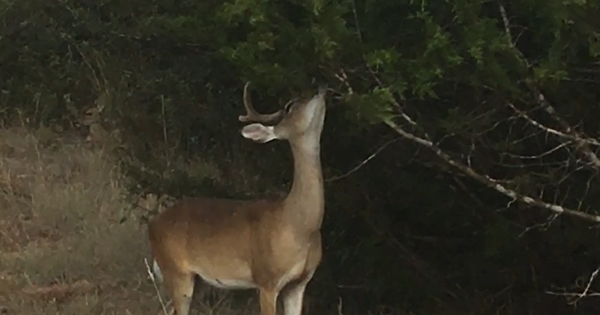A medium-size cedar (female Ashe juniper well past 14 years old) has been developing an unusually bare bottom over the past year or so. The property owner had noticed the progressing change but couldn’t figure out the issue. No other cedars nearby looked distressed and the rest of the cedar, to the top, was full and healthy. And then, one day, the property owner saw the culprit or, rather, culprits. White-tailed deer were nibbling on the lower branches of the cedar and they’ve been spotted doing same several times since then. Cedar are typically considered very low in palatability for deer (for everyone?) so it seemed odd behavior. Was this a preternaturally tasty cedar? Or simply a case of when you’re hungry, you’re hungry? As it turns out, deer eat a variety of things that might surprise you—including meat.
Cedar (and more) eaters
Cedar may be more common in a deer’s diet than what is generally believed but it may come down to tree preference. In “Cedar Through the Eyes of Wildlife” from Texas Natural Resources Server, the authors explored this particular type of deer foraging and found some interesting data. Highlights from their findings:
- Studies in northwestern Kerr County reported Ashe juniper comprised 0 to 34% of white-tailed deer diets.
- Tame deer foraging on “poor” condition range “spent 34% of their time during February consuming fruits and foliage of Ashe juniper.” Although range conditions were poor, the deer were not considered nutritionally stressed at the time “suggesting that cedar may not be as unpalatable as perceived.”
- In Llano and Mason counties, additional data found that Ashe juniper comprised, respectively, 12% and 20% of the annual diet of white-tailed deer.
- Finally, the authors noted that “deer seem to exhibit a preference for certain cedar trees, suggesting that some property (perhaps volatile oil concentration) varies intraspecifically (i.e., among individual juniper trees).” And at least one cited study suggested “that older female trees may be selected for by deer in search of foliage and/or fruits.”
Perhaps not too surprisingly, deer eat acorns—lots of acorns—but they can be picky about which of these easily digested snacks that are high in carbohydrates (42%) and fats (52%) that they’ll eat. While they are not as high in protein (6%), thanks to the sheer number of acorns eaten, they can provide the protein needed for healthy deer. (Source) Like wine drinkers who don’t like tannic wine, deer prefer their acorns low in tannins. White oak acorns, the preferred choice of deer, have the lowest level of tannins, making them something of a pinot grigio of acorns. Tannin levels vary among oaks with live oaks having the most tannins, a Chianti of acorns, and not appreciated by deer.
Meat eaters
“He ate a bird! Did you see that? Oh, my word.”
Those are the words you’ll hear in the aptly entitled “deer eating bird” video on YouTube. Posted in 2010, the woman is taking a video of birds flying around the head of a young buck that appears to be looking for something to graze as he slowly walks, nose to the ground. She finally realizes—and you’ll finally see if you watch the video (click here)—the buck is tracking an injured hatchling and the other birds are trying to distract him. Ultimately, the deer nabs the flailing bird and, yep, eats it. Along those lines, as described in “Field Cameras Catch Deer Eating Birds—Wait, Why Do Deer Eat Birds?,” when researchers in North Dakota set up “nest cams” over nests of songbirds, they found white-tailed deer predated more nests than foxes or weasels. And in Canada, a group of ornithologists used “mist-nets” draped between trees to gently trap birds or bats so they could be studied and released but the researchers did not get the opportunity to conduct their kind and gentle bird studies because “a herd of deer came by, they walked up to the struggling birds and ate them alive, right out of the nets.”
In addition to birds, white-tailed deer have also been documented eating other interesting food sources. From “The Meat-eating Habits of Deer”:
“There have been documented instances of deer eating squirrels and rabbits, although it is not known if it was the deer that killed them…Deer are also known to frequent gut piles and other animal remains and are often the first to show up at these sites…It is unknown if they seek out gut piles to eat the meat or simply the apples and other digested goodies lying about. As grisly as it may look, these methods may be tempting to deer during particularly harsh winters.”
In the event birds, other small game, and gut piles weren’t enough for you, we’ll leave you with an eyebrow-raising 2017 case report published in the Journal of Forensic Sciences. While we did not read the entirety of “White‐tailed Deer as a Taphonomic Agent: Photographic Evidence of White‐tailed Deer Gnawing on Human Bone” here’s the crux of the case in the study’s summary (if you haven’t already gleaned it from the title): “Herein, we report on the first known photographic evidence of deer gnawing human remains.”
Cheers to not so particularly harsh winters in Texas!
Photo, above: White-tailed buck snacking on a Texas Hill Country cedar tree, August 2020.









